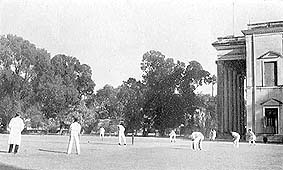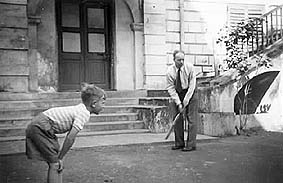

Cricket may not be the first association many people will have with the name Serampore, but, as a seven year old, I have a clear recollection of travelling north up the Grand Trunk Road, crossing the Hooghly from east to west, arriving at an imposing set of buildings by the river on a bright sunny day in the cold weather, and settling down to watch my father umpire a cricket match.


Family cricket in front of the Confidential Department at Baptist Mission Press, Calcutta. Was it unusual for an English child to grow up with the smell of printing ink and fresh paper in his nostrils; to see troops of monkeys commuting across the rooftops; or to hear the rhythmical clicking of a Monotype setting machine outside his bedroom window as he drifted off to sleep in an afternoon? It all seemed quite normal to me because my father was the Assistant Superintendent of Baptist Mission Press, Calcutta, and our family home was within the walls of the Press. (1) (2)
My father, Bernard Ellis, died in 1985, and I discovered amongst his possessions a biography of William Carey. I read it in order to try and discover whether the Press I knew had any connection with Carey. The story was gripping and compelling. It was a 1925, signed edition of S. Pearce Carey's biography 'William Carey' and must have sat on a bookshelf at the Press since the author signed it. Other people were mentioned, including Marshman and Ward but I could find no connection with the Baptists in Calcutta.
In 2003 I was able to get hold of a copy of the first edition of John Clark Marshman's 'The Life and Times of Carey Marshman and Ward', published in 1859. There, for the first time, was the full story of William Ward, the founder of the first Mission Press at Serampore. Amazingly, he was trained on the corner of Sadlergate and Irongate, Derby, just six doors along from where I had my own business. Since then there have been other finds, the most important being the discovery of 18 of some of the most important books by, and about, William Ward in the Derby Local Studies Library; many of them printed at Serampore. (3) (4)
This site is devoted to presenting the information contained in those books. It has been created within five or ten minutes walk of all the Derby sites mentioned in Chapters One and Two, and very close to where Ward and his family must have lived.
The text relating to his early years in Derby, Stafford, and Hull, comes from many sources and some speculation is involved. The story from his arrival at Serampore to his death is derived entirely from J. C. Marshman and Samuel Stennett and is told in their words. In this way I hope the reader is able to get as close as possible to the thought processes of this remarkable man and his colleagues. The original spellings for Indian words have been kept intentionally to provide authenticity. In the early 19th century, the situation in India was similar to that in medieval England at the time of Caxton. Spellings became fixed with the coming of printing and the publication of dictionaries, a process which Carey Marshman and Ward were bringing about in India for the first time.
William Ward was far more than just 'the printer' of the Serampore Trio and it is very fortunate that we have been left with so much material by Stennett and Marshman. It provides factual evidence of his many fundamental contributions to the success of the Serampore Mission.
Without the professional and patient help of the Chief Librarian and her staff at the Derby Local Studies Library; the in-depth knowledge and resources of Professor Bennie Crockett and 'The Centre for the Study of the Life and Work of William Carey D.D., 1761 - 1834'; the friendly encouragement and support of Edward and Rosemary Williams of the 'Friends of Serampore'; and the fine personal photographs of Serampore provided by Rev. Peter Shepherd, of Broadway Baptist Church, Derby, this site would not exist. To all of them I am sincerely grateful.
Ronald Ellis, Derby, 2004.
(1) For all sorts of information about Baptist Mission Press, Calcutta, go to the Miscellaneous Page.
(2) To see the Ellis family, click on this link.
(3) All the books have 20th century bookplates covering many existing late 19th century bookplates. There are two possibilities as to where the 18 books came from.
The most likely source is the Devonshire Collection. The seventh Duke of Devonshire, Sir William Cavendish, employed a Victorian Antiquarian called Llewellyn Jewitt to assemble a collection of books to form the basis of a Public Library for Derby in 1878.
The second, less likely, but more interesting source, is the Bemrose Collection. Its interest lies in the fact that William Bemrose, the founder of the Bemrose Corporation, bought the premises on the corner of Sadlergate and Irongate, from the Drewry family on 27th March 1839 ('Derbeians of Distinction', Maxwell Craven, 1998) and started his family printing business from there. He produced many religious books in the early years but made his fortune from printing timetables tickets, etc for the new, and growing form of transport, the railway. At the turn of the 20th century, Sir Henry Howe Bemrose devoted large resources to completing a massive bibliotheca of the county under the direction of Joseph Tilley and E. E. Taylor. It is tempting to think that Sir Henry Howe Bemrose may have known of, and taken an interest in, a former illustrious printer who had learned his trade in the same building in which his father had founded the Bemrose Corporation (now called BemroseBooth).
The 18 books were stored for more than a century in a gallery above the main Public Lending Library, and could be seen, but not accessed, by all visitors (see illustration). All the books that had never been requested were taken from the gallery and stored 'off site' in the southern Derby suburb of Peartree. That is where they were when I made a request to see them in February 2004. It is therefore probable that they had never been read, by anyone, since being collected in 1878. Judging by their condition, a very few of them had never been read before that date because the pages were uncut, ie, the pages were still joined together which is how they would have been sold at the time of publication. It was normal practice for the reader to have taken a paper knife and separated the pages themselves.
It is an extraordinary fact that these 18 books have now been moved to archives at the Derby Local Studies Library, on Irongate, that are less than fifty feet from where William Ward did his apprenticeship as a printer and edited the 'Derby Mercury'.
Copies of all the books held in Derby, along with the original diaries of William Ward and Daniel Potts' typed transcript of them, are held in the Baptist Missionary Society Archives at the Angus Library, Regent's Park College, Pusey Street, Oxford.
(4) For more information about the Devonshire Collection and the history of Derby Libraries there is a web page devoted to the subject, created by the School of Information, University of Texas at Austin, on their web site called Libraries & Culture, Bookplate Archive. The link will take you straight to the page.